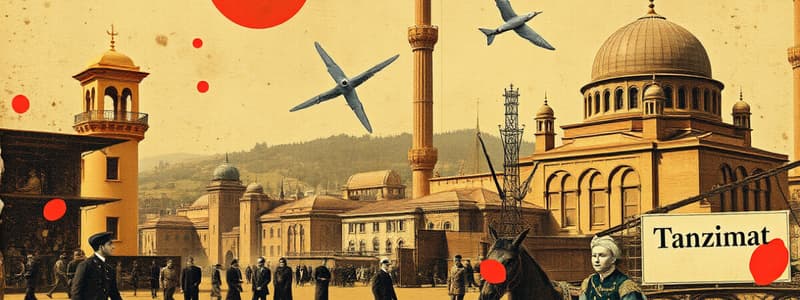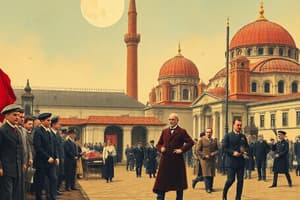Podcast
Questions and Answers
What were the Tanzimat reforms?
What were the Tanzimat reforms?
The Tanzimat reforms were a series of reforms in the Ottoman Empire between 1839 and 1876 that established a Western style university, state postal system, railways, and extensive legal reforms.
What is meant by the term 'ayan'?
What is meant by the term 'ayan'?
The wealthy landed elite that emerged in the early decades of Abbasid rule.
Who was Selim III?
Who was Selim III?
Sultan who ruled the Ottoman Empire from 1789 to 1807.
What were Mahmud II's significant contributions?
What were Mahmud II's significant contributions?
What was Abdul Hamid's approach to governance?
What was Abdul Hamid's approach to governance?
What was the main objective of the Ottoman Society for Union and Progress (Young Turks)?
What was the main objective of the Ottoman Society for Union and Progress (Young Turks)?
Who was Muhammad Ali?
Who was Muhammad Ali?
What was the significance of the Suez Canal?
What was the significance of the Suez Canal?
What was the Boxer Rebellion?
What was the Boxer Rebellion?
What led to the Taiping Rebellion?
What led to the Taiping Rebellion?
What were some causes of the decline of the Ottoman Empire?
What were some causes of the decline of the Ottoman Empire?
What were the reforms of Mahmud II?
What were the reforms of Mahmud II?
What impact did the Tanzimat reforms have on women's status?
What impact did the Tanzimat reforms have on women's status?
How did the Young Turks affect the Arabs in the Ottoman Empire?
How did the Young Turks affect the Arabs in the Ottoman Empire?
What led to the semi-Christian rebellion in southern China?
What led to the semi-Christian rebellion in southern China?
What did Abdul Hamid attempt to establish while still continuing reforms?
What did Abdul Hamid attempt to establish while still continuing reforms?
Who came to power as a result of the coup of 1908?
Who came to power as a result of the coup of 1908?
The sultan was reestablished as a figurehead after the coup?
The sultan was reestablished as a figurehead after the coup?
What commonality did Arabs have with the Turks?
What commonality did Arabs have with the Turks?
What significant event opened a new era of reforms in the Middle East?
What significant event opened a new era of reforms in the Middle East?
Who led the Mamluks during their defeat by Napoleon?
Who led the Mamluks during their defeat by Napoleon?
What were the consequences of Muhammad Ali's reforms in Egypt?
What were the consequences of Muhammad Ali's reforms in Egypt?
Muhammad Ahmad was known as the Mahdi?
Muhammad Ahmad was known as the Mahdi?
What was the outcome of the Battle of Omdurman?
What was the outcome of the Battle of Omdurman?
Who unified the Manchu nomads in the early 1600s?
Who unified the Manchu nomads in the early 1600s?
What was one result of minimal changes under the Manchu?
What was one result of minimal changes under the Manchu?
The examination system in Qing China ceased to fill its role in bringing forward ______ administrators.
The examination system in Qing China ceased to fill its role in bringing forward ______ administrators.
What was the Taiping Rebellion?
What was the Taiping Rebellion?
The Boxer Rebellion was successful in expelling foreigners?
The Boxer Rebellion was successful in expelling foreigners?
What did secret societies aim to achieve in Qing China?
What did secret societies aim to achieve in Qing China?
In what year did the Manchu lose power due to a revolution?
In what year did the Manchu lose power due to a revolution?
Flashcards are hidden until you start studying
Study Notes
Tanzimat Reforms
- Series of Ottoman Empire reforms from 1839 to 1876 aimed at modernization.
- Established a Western-style university, state postal system, railways, and legal changes.
- Resulted in the creation of a new constitution in 1876.
Key Figures in Ottoman Reforms
- Selim III: Sultan (1789-1807) focused on administrative efficiency and creating a modern army; overthrown by Janissaries.
- Mahmud II: Successfully established a private army, crushed Janissaries, and initiated significant reforms modeled on Western practices.
- Abdul Hamid: Sultan (1878-1908) attempted to revert to absolutism; nullified constitution, restricted rights, and later deposed.
Young Turks Movement
- Established by Ottoman Society for Union and Progress, opposing Abdul Hamid's regime.
- Aimed to restore the 1876 constitution and modernize the empire.
Egyptian Context
- Muhammad Ali (1811-1848): Rose to power post-Mamluk rule, reforming the army and challenging Ottoman authority; his policies led to debt and European intervention.
- Khedives: Descendants of Muhammad Ali who ruled Egypt until 1952, facing continual foreign intervention and control.
Historical Events in Egypt
- Suez Canal: Opened in 1869, financed by Europeans; increased debt and led to British political intervention.
- Arabi's Revolt (1882): Egyptian army officers revolted against Turkish dominance, prompting British military intervention and eventual control over Egyptian leadership.
Resistance and Rebellion in the Late Qing Dynasty
- Taiping Rebellion: Massive revolt (1850s-1860s) led by Hong Xiuquan, seeking to overthrow the Qing and establish social reforms; ultimately suppressed by provincial leaders.
- Self-Strengthening Movement: 19th-century efforts to modernize and adopt Western technologies amidst failures in governance.
Decline of Empires
- Ottoman Decline: Characterized by weak leadership, social unrest, inflation, and foreign competition undermining traditional crafts.
- Qing Dynasty Issues: Corruption and ineffectiveness in governance led to declining revenues and public discontent.
Reforms and Impact on Society
- Mahmud II's reforms: Focused on military restructuring and Westernization; however, artisan classes suffered due to increased foreign competition.
- Women's Rights: Although debated, little significant progress for women's status due to traditional resistance.
International Relations and Interventions
- Britain supported the Ottoman Empire to prevent Russian expansion and maintain control over the Mediterranean.
- French and British interventions in Egypt and the broader Middle East reflected regional instability and European imperial interests.
Summary of Political Discontent
- Young Turks initially supported by Arabs but later disappointed by continued imperial dominance.
- Resistance movements across the region highlighted the desire for autonomy from imperial rule and modernization efforts.### Jamal al-Din al-Afghani and Muhammad Abduh
- Advocated for rational inquiry within the Islamic tradition.
- Supported reforms against foreign financial control of the khedives.
British Control in Egypt
- Khedives faced financial struggles, resulting in increased control by British and French bankers.
- Ahmad Orabi led a revolt in 1882; British intervention restored khedivial authority.
Egypt and the Sudan Conflict
- Egypt's involvement in Sudan aimed at halting the slave trade met fierce resistance from Sudanic peoples.
- Muhammad Ahmad emerged as the Mahdi, opposing Egyptian and British control, and sought to purify Islam through jihad.
- Mahdi's military leadership established Sudan as an Islamic state until his death.
British Reoccupation of Sudan
- Following the Mahdi's death, Lord Kitchener led a British expedition to Sudan in 1896.
- The Battle of Omdurman in 1898 decisively defeated Sudanese forces, marking the end of the Mahdist state.
Nurhaci and the Qing Dynasty's Beginnings
- Nurhaci united Manchu nomads in the early 1600s, creating powerful banner armies.
- The Manchu adopted Chinese bureaucratic methods and employed scholar-officials.
- Seizing Beijing, they established the Qing dynasty, maintaining minimal changes to governance and supporting Confucianism.
Minimal Changes in Qing Society
- Social structure saw little alteration, except potentially a decline in women's status.
- Rural reforms aimed to enhance cultivation and infrastructure; outcomes were limited.
- Merchants thrived as compradors, connecting China to global markets.
Decline of the Qing Dynasty
- Examination system lost efficacy; positions were increasingly bought, undermining meritocracy.
- Public works suffered neglect, leading to disasters like flooding in Shandong.
- Increased banditry indicated state weakening and a perceived need for a new dynasty.
Opium Trade and the Opium War
- British merchants capitalized on opium exports to China, which led to widespread addiction and societal issues.
- Efforts to eliminate the trade culminated in the Opium War (1839-42) after Lin Zexu’s crackdown.
- China's defeat resulted in forced trade openings and the establishment of Hong Kong as a British outpost.
Taiping Rebellion
- Sparked by Qing failures and foreign interference, the rebellion was led by Hong Xiuquan.
- Although militarily effective, internal disunity and British opposition led to its downfall.
- The rebellion challenged both Qing authority and traditional social structures.
Cixi and the Self-Strengthening Movement
- Zeng Guofan spearheaded the self-strengthening movement, advocating for Western technology while resisting foreign influence.
- Dowager Empress Cixi opposed substantial reforms, hindering modernization efforts.
Boxer Rebellion
- The 1901 Boxer Rebellion aimed at expelling foreigners but resulted in increased European dominance over China.
Secret Societies and the End of Qing Dynasty
- Secret societies emerged to challenge Qing rule; although initially unsuccessful, they fostered future reformers like Dr. Sun Yat-sen.
- The 1911 revolution concluded the Qing dynasty, with civil-service exams abolished in 1905 after 2,500 years of tradition.
Studying That Suits You
Use AI to generate personalized quizzes and flashcards to suit your learning preferences.




